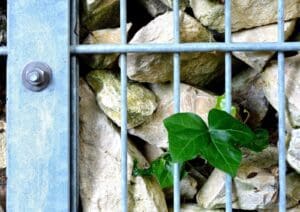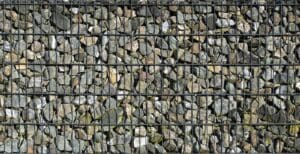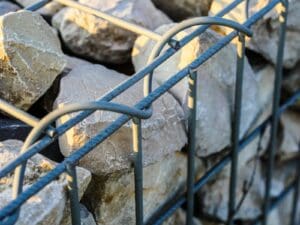How Gabions can be Used in Your Garden
Gabions are a valuable tool in your journey of growing a garden. Both aesthetically pleasing and helpful, there are many creative ways gabions can be used to enhance and help your garden. Here are some tips for using them most effectively.

Maintaining order in your garden
Gabions can aid in keeping your garden organized. They level the ground and prevent weeds from sprouting up in inappropriate places. By filling them with stones, you can create a natural-looking border that keeps your plants where they should be.
If you're growing vegetables, herbs, or other plants that need to be sorted by height, gabions can help with that as well. By building different levels of gabions, you can give each plant the amount of sunlight it needs without worrying about crowding each other out.
Not only does this method look more excellent than traditional rows, but it also helps your plants stay healthy by getting the right amount of sun and air. There are a few things to remember when using gabions for an organization. First, ensure the stones you use are smooth, so they don't damage the plants. Second, if you're using more than one level of gabions, secure them well, so they don't topple over.
Organizing your garden with gabions is a great way to add some extra flair while keeping your plants healthy and happy. Gabion structures can help contain or beautify the growth of some plants that tend to spread. It can be an excellent way to show off certain specimens while keeping the garden tidy. Some plants that work well in gabions are: Hostas, Daylilies, Liriope and Bamboo.
While gabions are a great way to organize your garden, some plants should not be grown in them. These plants have aggressive roots that can damage the stones or escape the confines of the gabion. If you're unsure whether a plant will work well in a gabion, it's always best to err on the side of caution. Some plants that are not suited for gabions are: Mint, Euphorbia, Iris setosa, Honeysuckle and Clematis.
Raised beds
Gabions can help create raised beds for your garden with minimal cost. All you need is some wire mesh, stones, and plants. This method is excellent for people who want to garden but don't have a lot of space.
To create a raised bed with gabions, start by measuring where you want your bed to be. Then cut the wire mesh to size and shape it into a cylinder. Next, fill the cylinder with stones and secure the top. Once your gabion is filled and secure, you can add soil and plants. Be sure to choose appropriate plants for the amount of sunlight the bed will get. If you're unsure which plants to choose, ask a local nursery or gardening store.
Gabions make it simple to raise many plants, which is necessary for their success. It is essential in gardens with poor drainage or that are located in flood-prone areas.
If you want to add a bit of extra flair to your raised bed, you can use different coloured stones or paint the wire mesh. You can also plant climbing plants outside the gabion to add some greenery. However, ensure you choose plants that won't damage the wire mesh.
Fencing
To help secure your garden, you can build a fence out of gabions. This type of fence is often used in commercial gardens or farms because it's durable and long-lasting.
To build a gabion fence, start by digging a trench around the perimeter of your garden. Then, cut the wire mesh to size and shape it into cylinders. Next, fill the cylinders with stones and secure the top. Once your gabions are filled and secure, you can add them to the trench. Be sure to compact the soil around the gabions to protect them.
A good gabion fence will:
• Be at least four feet high
• Have a minimum of two strands of wire
• Be made of non-corrosive material
• Include posts that are set in concrete
Gabions can be an attractive and low-cost way to create a fence around your pool. When choosing the material for your gabion fence, pick something that won't rust or corrode. You'll also want to ensure the posts are set in concrete, so they're secure.
Gabions walls are extremely sturdy and can keep out animals and give you privacy while working in your garden.

Irrigation fountains
Garden irrigation fountains can be made with gabions. They are simple to construct and come in decorative and practical varieties to water your landscape. Advantages of using a gabion for an irrigation fountain include:
• You can use any stone to create a water feature that compliments your garden's style.
• The water is recirculated back to the top of the fountain, so there is little to no waste.
• Gabion fountains are low maintenance and easy to construct.
If you're adding a gabion fountain to your garden, there are things to consider. First, you'll need to choose a location for your fountain. Choosing a spot that's level and has good drainage is essential. Otherwise, you run the risk of flooding your garden. Second, you'll need to decide what stone you want to use. The best stone for your fountain will depend on the look you're going for and the climate in your area. Third, you'll need to choose a strong enough pump to circulate the water through the stones. Fourth, consider adding a liner to your gabion to prevent leaks.
Retaining Walls
Gabions make great retaining walls for your garden. If you have a slope and experience soil runoff that puts your plants in danger of flooding or being carried away, gabions help manage and stop corrosion. They allow water to pass through while preventing the soil from being carried away with the water.
They are solid, durable, and cost-effective. You don’t have to pour concrete which can be a big expensive job. A gabion wall requires little maintenance, and will last a long time. When building your wall, here are things you should consider:
• The height of the wall
• The type of stone you want to use
• The size of the stones
• How you will secure the top of the wall
The height of the gabion wall obviously depends on the purpose of the wall. The fence should be at least three feet high if you're using it to manage soil erosion. The height will depend on your preference if you're using it as a decorative feature. The type of stone you use is also essential. Do your research on the best stones for your climate.
A wet environment demands a different kind of stone than a dry climate. A stone in a damp environment won't absorb water and crack in freezing temperatures. A stone in a dry climate can withstand high temperatures without being damaged. Stones you can use include: Limestone, Sandstone, Granite and Slate.
A stone suitable for a wet climate includes: Bluestone, Basalt and Flagstone.
The size of the stones is also essential. They should be big enough that the water won't carry them away but small enough that they can be easily placed in the gabion. The top of the wall needs to be secured. This can be achieved by using a wire or cable.
Gabions are a versatile and low-maintenance option for your garden. With a little creativity, you can use them for just about anything you decide!
Planters
Gabions can make good planters to have throughout your garden. They prevent soil from penetrating the rock and add variety to the landscape of your garden. You can use them to create a flower bed, a herb garden and a vegetable garden.
It is always nice to have a few raised planters for aesthetic purposes. Strawberries and lettuce are two examples of plants that thrive in raised pots. A gabion cage can make an excellent pot for these plants. Here is a procedure you can follow to transform gabions into planters:
• Line the gabion with a sheet of plastic.
• Fill the gabion with soil.
• Plant your chosen plants.
• Water regularly.
It is essential to line the gabion cage with plastic before adding soil. It will prevent the dirt from seeping through the stones and making a mess.
Advantages to creating planters this way.
• The gabion will last longer than most planters
• It is easier to control the amount of water the plants receive.
• The plants will be less likely to experience root rot.
Benches and walkways
Gabions can make great benches and walkways through your garden.
Here is how you can transform a gabion into a bench:
• Line the gabion with a sheet of plastic.
• Fill the gabion with soil.
• Pack the soil tightly to create a firm surface.
• Place a piece of wood or stone on top of the packed soil to create a seat.
To create walkways through your garden using gabions:
• Line the gabions with a sheet of plastic.
• Fill the gabions with soil.
• Pack the soil tightly to create a firm surface.
• Place stones on top of the packed soil to create a path.
To maintain:
• Water the soil regularly.
• Pack the soil tightly if it begins to loosen.
• Weed the stones regularly.
• Replace any stones that become loose.

Conclusion
Gabions are a versatile and low-maintenance option for your garden. With some planning, you can use them to create irrigation fountains, retaining walls, and other features. Make sure you use the correct type of stone for your climate and that you sufficiently secure the tops of your gabions. You can make great benches and walkways because they're durable and easy to maintain. By following these steps, you can ensure your gabions are not just for functional purposes. They will add beauty and variety to your garden and save you time and money in the long run.
